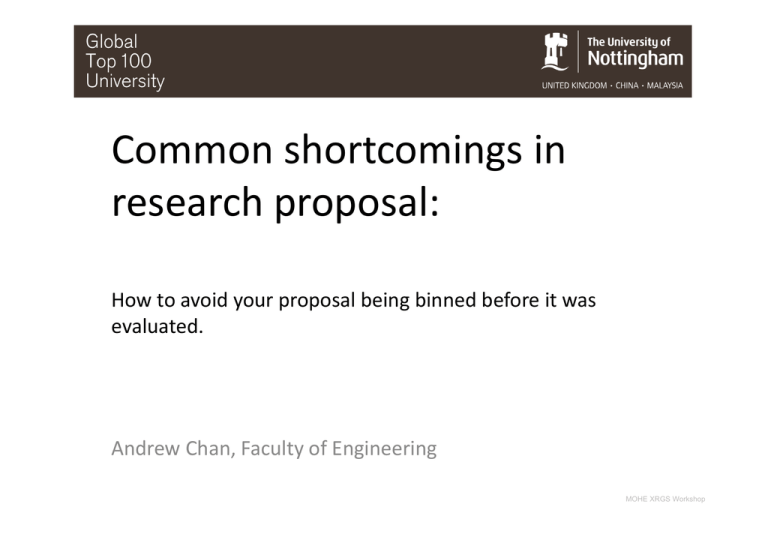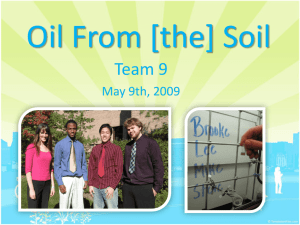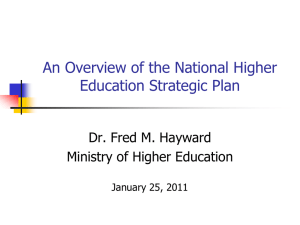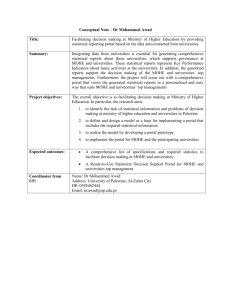Common shortcomings in research proposal
advertisement

Common shortcomings in research proposal: How to avoid your proposal being binned before it was evaluated. Andrew Chan, Faculty of Engineering MOHE XRGS Workshop First thing first • The first person to read your proposal (and the person who bins it first) will be an administrator. He / She will most probably be the only person who will read your proposal if your proposal were not reasonably well prepared. • Your proposal will only be read by experts if it passes through this barrier. • Only 30% of proposal are properly evaluated. MOHE XRGS W XRGS • FRGS (Fundamental) – background or theoretical research leading to state‐of‐the‐art invention • ERGS (Exploratory) – preliminary work on untested ideas; ventures into emerging research ideas; application of new approaches to existing research; quick‐response research to unanticipated events; catalysis of innovative advances • PRGS (Prototype) – proof of concept on product for commercialisation, based on ERGS • LRGS (Long‐term) – 5‐year research plan, at least 3 universities, applied by professors only • • • • • • Success rate: <10% (University hit‐rate 2011 ~12%) FRGS (RM 50 – 100k, 1‐2 years) ERGS (RM 80 – 200k, 2‐3 years) PRGS (RM 100 – 500k, 2‐3 years) LRGS (RM 10 – 10M, 5 years) http://jpt.mohe.gov.my/eng/menupenyelidik.php NKEA Sea to Space Biotechnolo gy Information and Communica tion Technology Science and Technology Core Industry • • • • Make sure all instructions are properly followed. Make sure all boxes are ticked. Partner with a local government agency like MPOB, MIMOS… Make sure the executive summary (or anything on the first two or three pages) can be understood by a layman. • Try something like: Ask your mom to read your proposal for three minutes and see what are her comments (EPSRC suggestion). MOHE XRGS W General points in the proposal • Is the problem well‐formulated and presented? – Objectives and methodology • Are the objectives quantifiable and measureable? – Objectives • Why do this research? Why is it important to be funded? – Executive summary and background • Where is the research gap? What is the contribution? – Executive summary, background and literature review • Is the proposer qualified and capable to do the work? – Literature review • Is the proposal focussed and organised? – Methodology MOHE XRGS W Example (Title of proposal) • Development of systhematic evaluation and optimisation tools for retrofitting palm oil mill to integrated biorefinery complex and detail allocation of palm oil biomass to produce value‐added products • Integration of retrofits to improve the efficiencies of Malaysian biomass energy supply chain MOHE XRGS W Example (Excerpt of proposal) Recent studies on nanoporous carbonaceous materials along with proprietary binder/conductive additives yielded supercapacitors capable of delivering pulse power with capacitance as high as 150F/g. This can be easily scaled up to any industry standard including OEM requirements. Also, our proprietary fabrication of flexible laminate cells prove our expertise in producing high power Supercaps for applications requiring pulse power capabilities such as today’s all communication gadgets. Our key to our success is the low ESR value ensured by the intimate current collector foils and electrode material coating contact via processed surface finishing. Besides, our nano metal oxide thin film electrodes along with nanoporous carbon blacks provide high energy densities. Improvements in further conditioning coating procedures suitable for bulk manufacturing is a crucial challenge with tailored pore structure/surface area of carbon electrodes together with their electronic conductivities as well as the stability of the electrolyte, current collector and interconnections between pairs of electrodes, should increase the performance of the supercapacitors for next generation applications. This proposal envisages the development of various process methods to realise a lab prototype hybrid cells by way of optimizing the electrode calendering process for large area thin electrode assembly using casting techniques. These tape casts will be used to fabricated thin slim size and large size (3-50 F) Prismatic and Pouch type flexible Hybrid Supercapacitors. These packages will test and optimize the packaging of Prismatic and Pouch type design for high power electrical applications as well. The assembled cells will be demonstrated in powering of Actuator Electronic Circuits, for instance Camera phones, Solar PV Maximum Power Point (MPP) trackers etc. Any of these loads will be suitably chosen to test the final product in actual load applications to test their effects. Research into the production methods of biodiesel from second generation feedstock offers many untapped opportunities for further development, in part because alternative fuel is set to become more important and will affect all energy technologies used now and on coming stream. There are also considerable interests within the agricultural sector to better utilise low-cost crops such as Jatropha curcas, especially in producing biodiesel due to its cost, efficiency, yield and arable land requirement. In fact, Malaysia is now driving to develop its strength in this area with the establishment of many governmental incentives and measures such as the Bionas Agropolitan Technology Corridor Development. Set against this background, the key objective here is to develop a solid base catalyst from coal flyash for a more environmentally-friendly and efficient transesterification process to produce Jatropha biodiesel. In line with this, transesterification parameters, properties of the biodiesel produced and engineout performance/emissions are also evaluated accordingly. The research programme proposed here comprises 3 main stages of work. Stage 1 deals with the synthesis and characterisation of a solid base catalyst from coal flyash. Next, a laboratory-scale reactor is setup to study the effects of transesterification parameters on the yield/purity of the Jatropha biodiesel, and how these are enhanced or moderated with the use of different types of solid base catalysts. The last phase of the work determines the fuel properties of the Jatropha biodiesel, along with engine performance and exhaust emissions of the biodiesel from a light-duty diesel engine at specific speed-load conditions. The project is expected to produce a relatively higher value-added product in the form of a solid base catalyst from waste coal flyash. Detailed understanding and knowledge in the interactions between transesterification variables and types of solid base catalysts, as well as the kinetic model of the process will be acquired. Most importantly, the performance of the flyash base-catalysed transesterification and the optimum operating conditions will be determined concurrently. The feasibility of using this catalyst will be assessed through the properties of the Jatropha biodiesel produced, and how the fuel performs in an automotive diesel engine. The proposal should benefit investments in Jatropha curcas plantations by adding value to the crop, as well as providing a cost-effective, greener solution to the biodiesel industry in feedstock and processing options. 9 MOHE XRGS W Example (Objectives) • • • • • • • To study a quark‐based power system on photovoltaics, wind energy, fuel cell To investigate the use of fuel cells in power hybrid application compared to conventional batteries To research the integration of quark‐based into hybrid system To investigate different sizing methods for the hybrid system to work with fully renewable components without adding any diesel generators To design an energy management system for the hybrid system tha maximises its efficiency and minimise power supply loss To investigate off‐grid and grid connections for different operating conditions ... MOHE XRGS W • • • To evaluate the performance of a quark‐based power system on a hybrid power system To determine the performance of this quark‐hybrid system in various renewable energy systems To design energy management system for this hybrid system for different operating conditions in general renewable energy usages MOHE XRGS W Example (Literature review) Tumeo et al. (2012) have shown the ability of ultrasound of varying pressures and amplitude to induce physical thermodynamic changes and in contaminants adsorbed onto the surface of activated carbon. Recently, Tumeo et al. (2012) studied the removal of Cu(II) ions from aqueous solution by ultrasound assisted adsorption onto the granular activated carbon obtained from hazelnut shells. They have observed that the maximum adsorption capacity of the adsorbent for Cu(II), calculated from the Langmuir isotherms in the presence of ultrasound was 3.7 mmol/g is greater than that in the absence of ultrasound which was 3.14 mmol/g… MOHE XRGS W Work done by others … Work done by the principal investigator (PI) Chan (2002a) showed for the first time correlation between IO and meteorological factors. The PI did measurements the concentrations of nitrogen oxides and suspended particulate matter (RSP) in a student office and correlated the IO ratio with various outdoor climatic factors like temperature, humidity, pressure, wind speed and solar irradiation. Moreover, Chan (2002b) also studied the variations of IO with reference to various human activities such as the presence of human and general human activity patterns. Several observations were made (Chan 2011a): Temperature, humidity and wind speed are the three most prominent climatic factors that concern IO. Little correlation is observed with pressure and solar irradiation despite common belief. Control of either indoor or outdoor climates can help change the IO and thus the indoor air quality. Gaseous pollutants offer a significantly different penetration rate than RSP. The variation pattern of IO follows roughly that of human activities. MOHE XRGS W Common comments (and reasons for rejection) • Unclear and unfocussed proposal. • The objectives are immeasurable and unfocussed. • The proposal is a routine application of a known technique or research. • The proposer is not qualified or capable. • The proposal is not of national interest. • The proposal is poorly presented. • Unrealistic and overly ambitious within the given time frame. • Poor English. • Ticked the wrong boxes. • … MOHE XRGS W Having said all that… • Getting grants is an integral part of being an academic. It is the rule of the game. • Rejection is part of the package of being an academic. • Keep trying, and we’ll do whatever to support those who try. • You’ll succeed eventually. MOHE XRGS W References • • • • • Anonymous 2012, Why proposal don’t get funded, http://www.einstein.yu.edu/ogs/Guide/Hints.htm#Common Reasons for a Poor Review, accessed 1st September 2012 Anonymous, 2012, Guidelines for writing grant applications, http://www.bioscience.org/current/grant.htm, accessed 14th September 2012 Levine, S.J., 2012, Guide for writing a funding proposal, http://www.learnerassociates.net/proposal/, accessed 1st September 2012 Jones, S.P. & Bundy, A. 2012, Writing a good grant proposal, http://research.microsoft.com/en‐ us/um/people/simonpj/papers/proposal.html, accessed 15th September 2012 White, C. & Castelloe, P. 2012, Writing a grant proposal, http://www.cpcwnc.org/resources/toolbox/writing‐a‐grant‐proposal, accessed 13th September 2012 MOHE XRGS W



